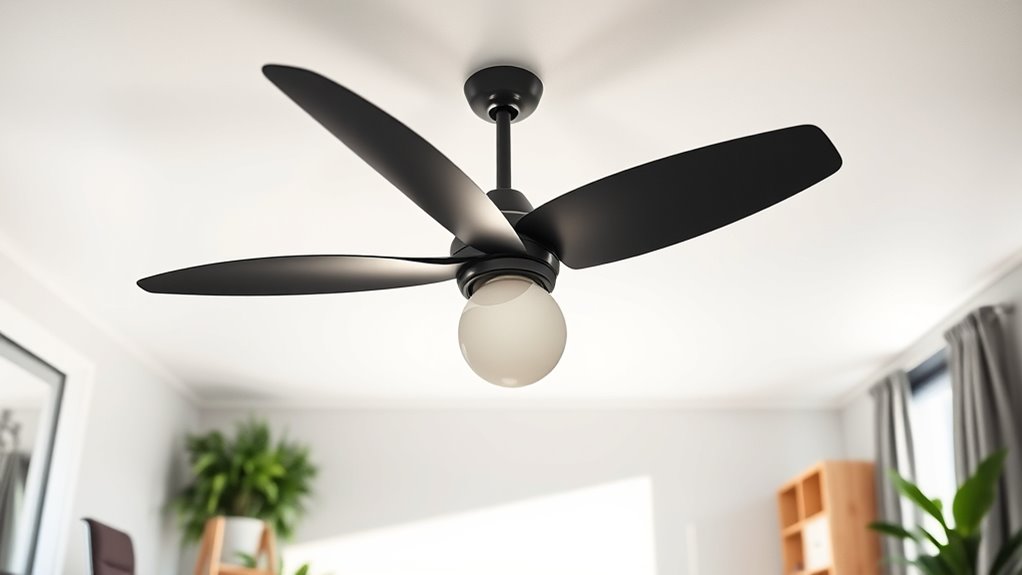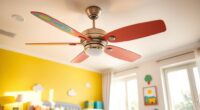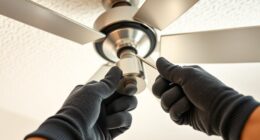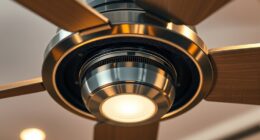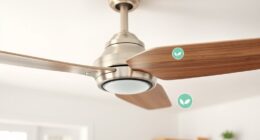To choose the right ceiling fan for your home office, focus on proper placement, ideally centered and at least 8 feet high for ideal airflow. Pick a size based on your room’s dimensions, and consider styles and lighting options that match your decor. Think about control methods like remote or smart systems, and guarantee the fan suits your ceiling height, especially in vaulted spaces. Keep energy efficiency in mind to stay comfortable and save on bills. If you want more tips, you’ll find all the details you need below.
Key Takeaways
- Choose a size and blade diameter suitable for your room dimensions to ensure efficient airflow and safety.
- Install the fan centrally at least 8-9 feet above the floor, using downrods for high or vaulted ceilings.
- Select styles and finishes that complement your office decor, with options for lighting and reversible blades for seasonal updates.
- Use remote controls, wall switches, or smart technology for convenient airflow and lighting adjustments.
- Opt for energy-efficient motors and proper mounting to maximize comfort, airflow, and cost savings.
Choosing the Perfect Location for Your Home Office Ceiling Fan
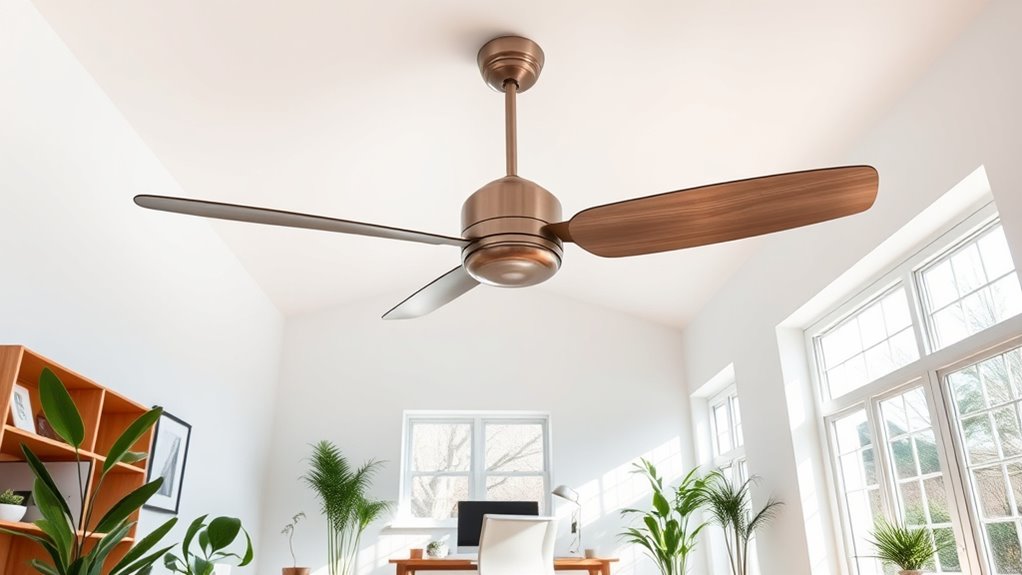
To guarantee your ceiling fan effectively cools your home office, it’s important to choose the right location. Proper ceiling fan placement ensures even air circulation and ideal ventilation. Position the fan centrally in the room to maximize airflow coverage, avoiding areas directly over desks or workspaces that could cause drafts. Install the fan at least 8 to 9 feet above the floor for fan height safety, adjusting with downrods if you have higher ceilings. Consider your room layout and natural ventilation patterns to prevent obstructions from windows or vents. For vaulted or sloped ceilings, use appropriate fan mounting accessories like angled adapters or extended downrods for proper installation. Proper placement also helps prevent airflow obstruction, ensuring the fan operates efficiently and maintains a comfortable workspace. Additionally, understanding air circulation principles can help optimize fan placement for better comfort and energy efficiency. Being aware of ventilation dynamics can further enhance how well your fan performs in maintaining a consistent temperature. Incorporating energy-efficient fan designs can also contribute to lower energy costs while keeping your workspace comfortable. Thoughtful fan location and proper installation improve air circulation and maintain a comfortable workspace.
Selecting the Right Size and Diameter for Your Office Space

Choosing the right size and diameter of a ceiling fan guarantees effective airflow in your office. Smaller rooms, like those under 225 sq ft, need fans with blades around 42-44 inches, which helps optimize air circulation and energy efficiency. Additionally, selecting a fan with appropriate tuning options can enhance its performance and energy efficiency in your office environment. Proper sizing not only improves comfort but also maintains safety by keeping the fan at the correct height. Larger spaces over 400 sq ft require fans of 52 inches or more to ensure proper cooling. Considering water park safety guidelines can also ensure a secure and enjoyable workspace, especially if your office has a recreational or wellness area. Regular maintenance and performance upgrades can further maximize your ceiling fan’s effectiveness and longevity. Incorporating remote control features can also provide convenient adjustments to airflow and speed without disrupting your workspace.
Room Size Compatibility
Ever wonder how to pick the perfect ceiling fan size for your home office? Your room size is key to choosing the right fan.
For spaces up to 144 sq ft, a ceiling fan with a blade span of 29-36 inches provides effective airflow and ventilation. Optimal airflow depends on selecting a fan that matches your room dimensions. Proper automation technologies can also help improve overall comfort and efficiency in your space.
Larger rooms exceeding 225 sq ft need fans of 52 inches or more to ensure proper airflow and room compatibility. room size compatibility helps prevent issues like inadequate airflow or excessive noise, ensuring your home office remains a comfortable environment. Additionally, considering vibrational comfort can contribute to a quieter, more stable operation.
Using a fan that’s too small can result in poor ventilation, while an oversized fan may cause excessive airflow, noise, and clutter. Selecting the right fan size guarantees effective cooling, enhances comfort, and maintains a balanced room aesthetic.
Optimal Blade Diameter
Selecting the right blade diameter guarantees your ceiling fan provides ideal airflow for your office space. The blade diameter directly affects air circulation, so choosing the optimal size is vital for comfort. Proper sizing can also help prevent excess noise and ensure the fan remains stable during operation. For rooms measuring 100-144 sq ft, a ceiling fan with a blade span of 36-44 inches works best, ensuring efficient airflow without noise. If your office is between 144-225 sq ft, opt for a fan with a blade diameter of 44-52 inches to maintain proper circulation. For spaces over 225 sq ft, a fan with blades spanning 52-60 inches delivers sufficient air movement. Matching the fan size to your room’s square footage ensures balanced fan performance, prevents wobbling, and avoids inefficient airflow. Refer to a ceiling fan sizing guide to select the ideal blade diameter for your room. Additionally, consider the blade pitch, which impacts airflow and efficiency, to optimize your fan’s performance. Understanding the energetic alignment of your space can further enhance the comfort and effectiveness of your ceiling fan, creating a more harmonious environment. Proper placement and installation height are also crucial for achieving optimal performance and safety.
Finding a Style That Complements Your Home Office Decor

To find a ceiling fan that enhances your home office decor, focus on how its style and finish align with your existing space. Choose a ceiling fan style that complements your decor, such as sleek modern ceiling fans with minimalist fan designs or traditional fans with ornate details for classic themes. Fan finishes like brushed nickel work well in modern spaces, while matte black suits contemporary designs. Reversible blades allow you to adapt to seasonal decor, providing a wood finish for warmth in winter and a neutral color for summer. For smaller or cluttered offices, opt for fans with simple, clean lines to maintain a professional look. If your decor includes lighting fixtures, consider fans with integrated lighting that match your furniture for a cohesive, polished appearance. Incorporating interior design principles can further help you select a fan that harmonizes with your overall decor style, especially when considering energy-efficient options that complement eco-friendly interior themes. Additionally, selecting a fan with smart home compatibility can enhance convenience and energy management in your workspace.
Deciding Between Fans With or Without Integrated Lighting
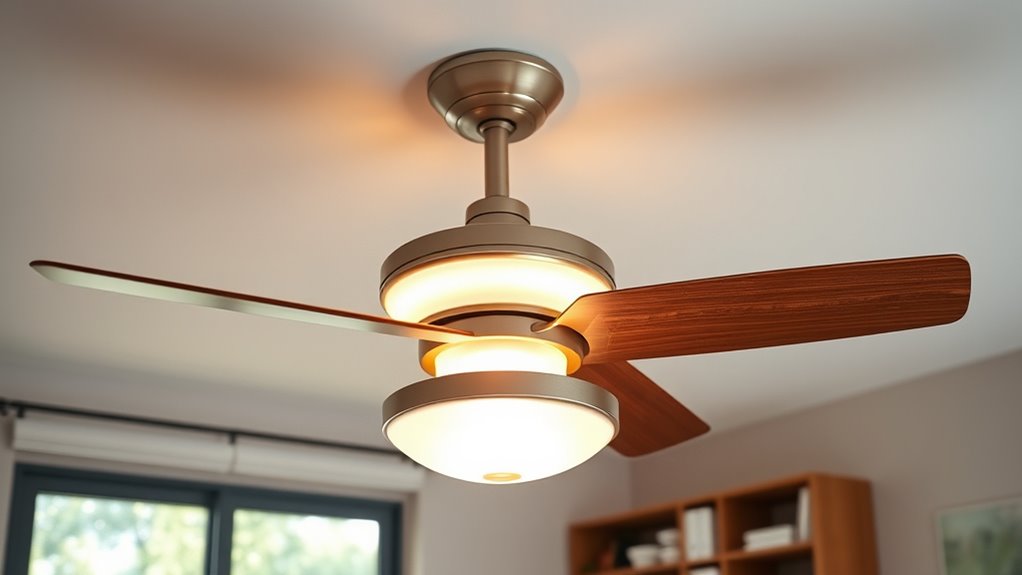
When choosing a ceiling fan for your home office, considering whether it has integrated lighting or not can make a significant difference in both function and style. Fans with lights, also called ceiling fan lighting, offer a streamlined look by eliminating the need for separate fixtures and providing centralized control.
With LED-compatible light kits, you can enjoy dimmable lighting that enhances your workspace ambiance. Fans with integrated lighting are ideal if your room needs better illumination, especially in spaces with limited natural light.
On the other hand, fans without lights provide more lighting flexibility, allowing you to add or adjust fixtures later to suit your aesthetic preferences. Your choice depends on your lighting needs, existing room brightness, and preference for a clean, cohesive design.
Mounting Options and Heights Suitable for Home Office Ceilings
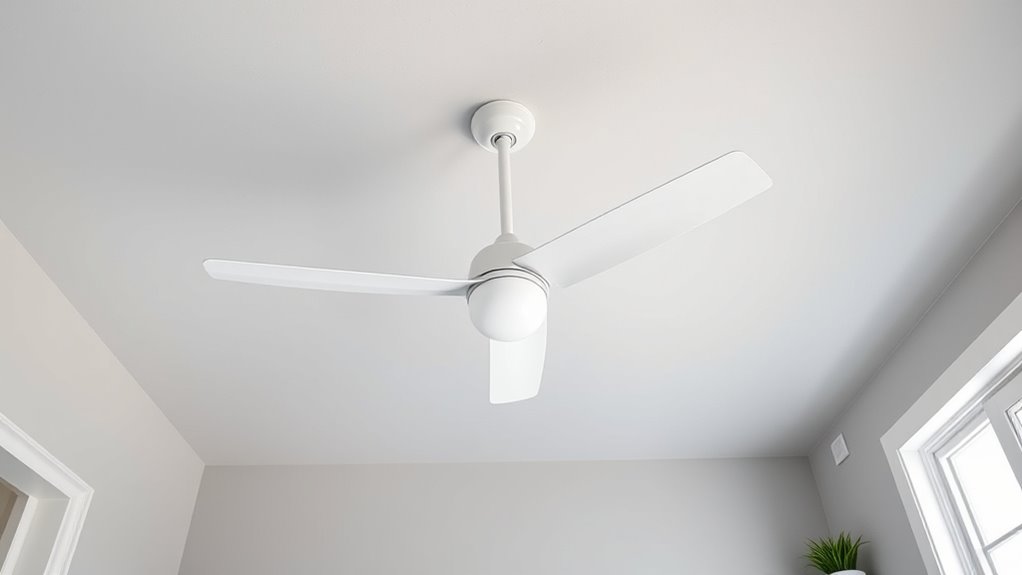
Choosing the right mounting option and height for your home office ceiling fan is essential for both safety and effective airflow. For standard 8-foot ceilings, a flush mount or low-profile fan keeps headroom clear. If your ceiling exceeds 9 feet, a fan with a downrod helps maintain the ideal 8-9 feet height for ideal circulation. For taller ceilings or sloped (vaulted or angled) ceilings, angled mounting brackets or extension kits ensure safe, secure installation. Consider your ceiling height and type to select the best fan mounting options. Here’s a quick overview:
| Ceiling Type | Mounting Option |
|---|---|
| 8 ft (standard) | Flush mount, low-profile |
| >9 ft (high) | Downrod, extended mounting |
| Sloped or vaulted | Angled mounting, adapter kits |
Controlling Your Fan: Remote, Wall, or Smart Systems
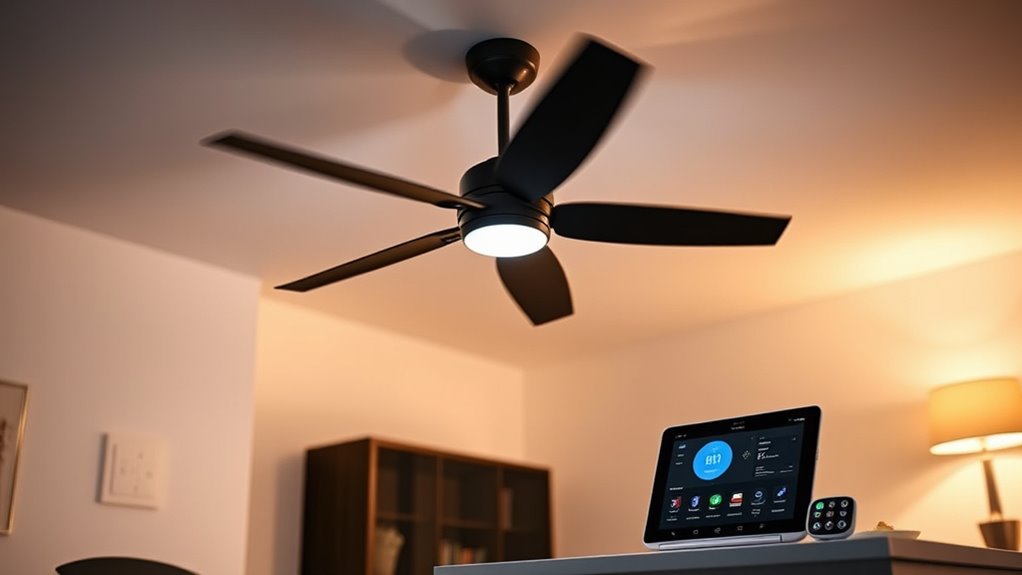
Controlling your ceiling fan with the right system can greatly enhance your home office experience. A remote control allows you to adjust fan speed, light, and direction from up to 30 feet away, keeping you comfortable without leaving your desk.
Wall switches provide quick access inside the room for fan control and light dimming, ideal for fixed locations.
Smart home technology offers Wi-Fi-enabled fans that you can manage via an app on your smartphone or tablet, giving you customizable schedules and remote operation.
Voice assistants like Alexa or Google Assistant make controlling your fan even easier through voice commands.
Many fans include multiple control options, so you can choose what works best.
Smart controls also promote energy efficiency by tracking usage and integrating with your home automation system.
Ensuring Optimal Airflow and Energy Efficiency in Your Workspace
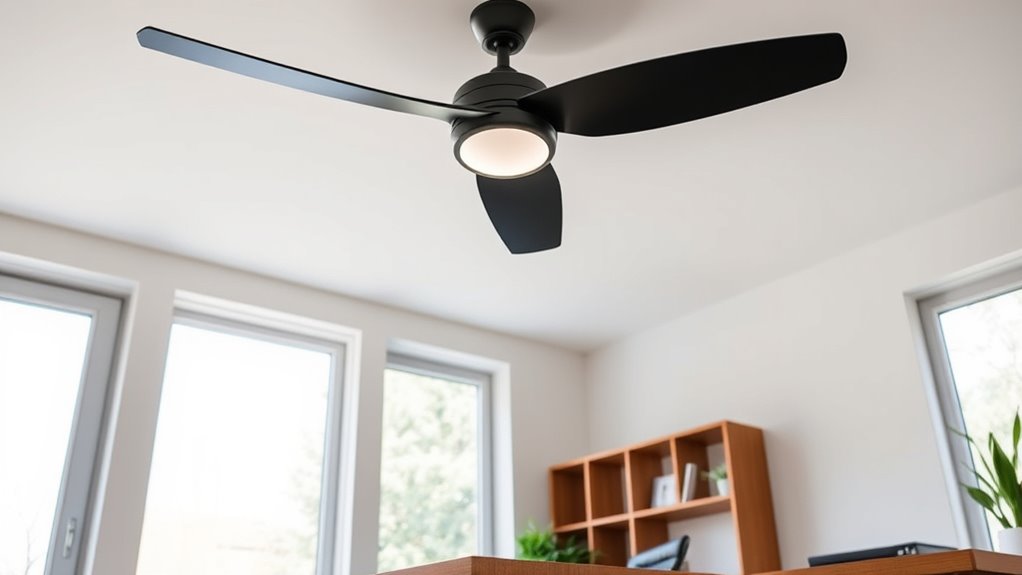
To guarantee your home office remains comfortable and energy-efficient, proper airflow is essential. Ceiling fans with the right fan size and higher CFM ratings—around 400-700 CFM per 100 sq ft—boost airflow efficiency, keeping your workspace cool and comfortable.
Installing fans at an ideal height of 8-9 feet and positioning them correctly maximizes airflow and energy savings. Reversible blades help circulate warm air in winter and cool air in summer, maintaining consistent comfort year-round.
Choosing fans with energy-efficient motors, like DC models, reduces electricity use and noise, further enhancing workspace efficiency. By adjusting blade direction seasonally and selecting the right fan placement, you ensure maximum airflow and energy savings, making your home office both comfortable and cost-effective.
Budget-Friendly Ceiling Fan Options for Home Offices
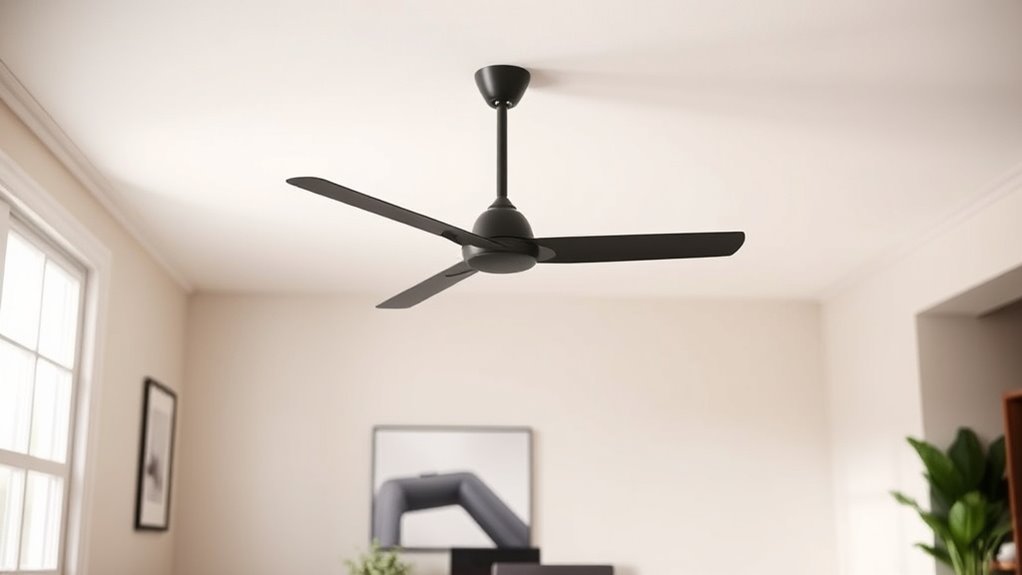
Finding an affordable ceiling fan for your home office doesn’t mean sacrificing quality or essential features. Budget-friendly ceiling fans, typically costing between $50 and $150, offer reliable performance with quiet operation and multiple speeds.
Many models include energy-efficient LED light kits and remote controls, adding convenience without extra costs.
Brands like Harbor Breeze, Honeywell, and Westinghouse are known for producing affordable, durable options suitable for your workspace.
A size of 42-44 inches strikes the right balance, providing effective airflow without overwhelming the room.
Basic designs in white or brushed nickel blend seamlessly with your decor while keeping costs down.
With these options, you can enjoy an energy-efficient, quiet, and functional ceiling fan that fits your budget and enhances your home office environment.
Key Features to Consider for Enhanced Comfort and Convenience
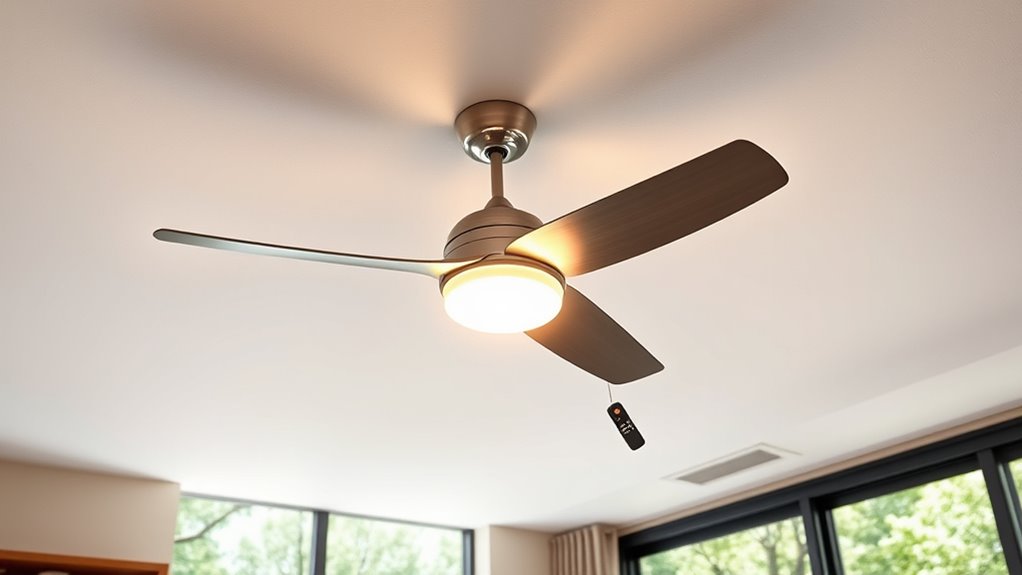
Choosing the right ceiling fan for your home office involves prioritizing features that boost comfort and convenience. Look for fans with remote control or smart app controls, so you can easily operate them from across the room or your phone.
Select ceiling fans with remote or app controls for easy operation and enhanced comfort.
Adjustable speeds, ideally three or more, let you customize airflow based on your needs, while reversible blades and motors help optimize comfort year-round.
An energy-efficient design, with DC motors and LED lighting, reduces electricity costs and provides bright, efficient illumination.
Guarantee the fan’s quiet operation stays below 50 decibels to keep distractions minimal.
Consider fan size to match your space for even airflow.
These features combine to create a more comfortable, convenient, and efficient workspace in your home office.
Frequently Asked Questions
What Is the Rule of Thumb for Ceiling Fans?
The rule of thumb for ceiling fans is to choose a size that fits your room’s dimensions, typically 36-50 inches for spaces up to 400 square feet.
You should install the fan so the blades are about 8-9 feet above the floor for safety and ideal airflow.
Use downrods for higher ceilings and place the fan centered for best circulation, ensuring it runs quietly and efficiently.
Is a 52 Inch Fan Too Big for a 12X12 Room?
A 52-inch fan isn’t too big for your 12×12 room. Although slightly above the typical 36-50 inch range, it can still work well if you install it correctly and guarantee it’s balanced.
The larger blades may create a more noticeable presence, but they won’t cause airflow issues if the fan has a good blade pitch and adjustable speeds.
Just make sure it’s properly mounted for maximum comfort.
What Are the Guidelines for Ceiling Fans?
When considering ceiling fan guidelines, you should guarantee the fan is at least 8-9 feet above the floor for safety.
For a 12×12 room, a 42-44 inch fan works well, providing effective airflow without overwhelming the space.
Position the fan centered in the room, with blades 10-12 inches below the ceiling.
Use adjustable downrods if your ceiling is higher, to maintain proper height and airflow.
What Size Ceiling Fan for a Small Office?
Think of your small office as a cozy nook, and the ceiling fan as its gentle breeze. For spaces up to 100 square feet, you’ll want a fan between 29 and 36 inches in diameter. This size is like a well-tuned instrument, providing just the right airflow without overwhelming your space.
Make sure to match it with your ceiling height for a perfect blend of comfort and style.
Conclusion
By thoughtfully choosing your ceiling fan, you gently create a more comfortable and inviting home office environment. A well-selected fan subtly enhances your workspace, making long hours feel a bit lighter. With the right style, placement, and features, you’ll enjoy a harmonious balance of airflow and efficiency. So, take your time to pick the perfect fan — it’s a quiet step toward a more pleasant and productive day, every day.
